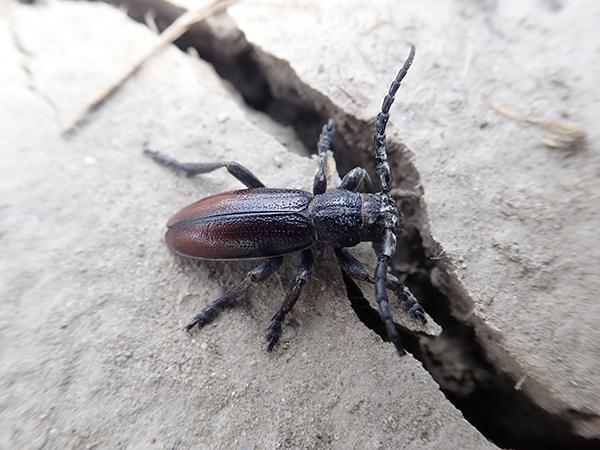HUN-REN CER research project helps protect wildlife from the harmful environmental effects of ivermectin
The Life for Bugs and Birds research project, supported by the European Union Life program, was launched two years ago at the HUN-REN Centre for Ecological Research (HUN-REN CER). Its goal is to develop innovative management practices for the Pannonian saline steppes and loess steppes. One of its most crucial elements is the development of conditions for keeping grazed animals without the use of ivermectin dewormers, as this substance poses a significant threat to the local insect and bird populations when released into nature. According to Szabolcs Lengyel, scientific advisor at HUN-REN CER and leader of this project, significant results were already achieved in the first two years.

The Puszta Longhorn Beetle (Dorcadion fulvum cervae) is the native subspecies of the Kiskunság saline grasslands and is one of the important target species of the project
Arthropods are drastically declining worldwide. This can be attributed to numerous, region-specific factors, but in many cases, human activities altering habitats also play a role. In grazed areas, one such harmful human intervention is the use of dewormers, such as those containing the ivermectin agent, applied in many places. When released into the environment, these substances can harm local wildlife. The HUN-REN CER Life for Bugs and Birds research project aims to mitigate this danger.
"The main goal of the project is to develop, implement, and disseminate insect- and bird-friendly grazing methods," emphasised Szabolcs Lengyel. "Grazing animals are released onto the pasture early in spring, and through their manure, dewormers also reach the environment. Dung beetles tunnel into the dung or disperse it, and the dewormer destroys their eggs or hatching larvae. It is clearly evident that, in the absence of offspring, the population of arthropods can decrease by as much as a third to half within just five years due to grazing animals treated with ivermectin."
To address this issue, it is necessary to prevent the release of ivermectins into the environment. The simplest way to achieve this would be to discontinue the use of this agent in animal farming. However, this is an unrealistic expectation in the current situation, as it is a highly effective substance crucial for modern and economically sustainable animal farming. Therefore, ecologists must find methods that allow coexistence with the veterinary use of ivermectin while ensuring the preservation of the natural ecosystem.
However, even changing the timing of ivermectin treatment can contribute significantly to reducing environmental pollution. The substance breaks down relatively quickly and is eliminated from the animal's system within six weeks. Therefore, if animals are treated with it six weeks before or after the grazing season, for example, in November, they will not excrete dewormers in their manure during the grazing period.
In the grazing areas studied by the researchers from HUN-REN CER, there are also farmers who treat their livestock with ivermectin after bringing them in during November. This way, the animals do not carry the parasites collected on the pasture to their winter shelter. However, when they are released back to the pasture the following spring, they will be "clean," meaning they will not excrete ivermectin.
"This clearly shows that even with small changes, significant conservation benefits can be achieved, as flies, beetles, and other arthropod species play a crucial role in breaking down manure," continued Szabolcs Lengyel. "Insects create holes in the dung, increasing its surface area and providing space for decomposing bacteria. Therefore, if there is no insect community in the pasture, the breakdown of manure may become impossible. In pastures with animals treated with ivermectin, it sometimes happens that the dung from the previous year remains in the area even in the next spring, significantly degrading the pasture's value."
This proves that it is in the farmers' fundamental interest for the pasture's insect community to remain healthy. In developing insect-friendly grazing, ecologists aim to achieve this very goal. The project has been ongoing for two years now, and in the examined area within the Kiskunság National Park, specifically in Miklapuszta located between Harta and Akasztó, insect-friendly grazing has already been initiated. Sheep grazing takes place in the central area, currently with around three hundred ewes. The grazing infrastructure has been established in the northern part of the area, including the construction of the summer sheepfold and the associated shepherd's shelter. Since the end of July, continuous grazing has been conducted here.
The research project not only examines the impact of grazing on insect communities but also investigates the processes of bird populations consuming insects, with a particular focus on four shorebird species – the Kentish plover, the stone curlew, the black-winged stilt, and the avocet. "A notable success of the program is that, for the first time in many years on the ivermectin-free central area, two pairs of Kentish plovers have nested," noted the project leader. "The pairs successfully hatched their eggs, although later the chicks were destroyed by hooded crows. Nonetheless, it is definitely encouraging that these birds reappeared in the pretreated, cattle-grazed, and mowed central area."
In the other areas of the pasture under investigation, conventional grazing takes place, meaning that animals are treated with ivermectin and other deworming agents. In these areas, ecologists have created artificial habitats – such as woodstacks, manure piles, and insect hotels – for arthropods before the onset of winter, providing places where they can hide, reproduce, and feed. The researchers hope that these artificial habitats will promote the overwintering and reproduction of insects in the coming year.

